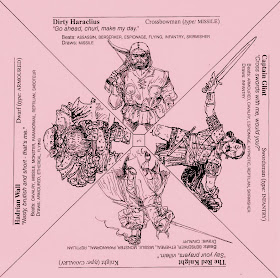 The third and final part of my quickplay RPG rules...
The third and final part of my quickplay RPG rules...COMBAT
Combatants act each round in descending order of Mind score. You can take one action, either an attack or a parry.
The attacker's degree of success minus the defender's degree of success is the amount of damage that gets through to the defender's armor. The defender can then make an armor roll, and the degree of success of this roll is how much of the damage the armor absorbs.
armor values
leather 5
light 7
medium 8
heavy 9
shield +2
Use the higher of the dice scores for the degree of success of an armor roll. Unlike an ability roll, the armor roll cannot be optionally modified.
SPELLCASTING
Spells can be based on any RPG system you like. To attempt a spell you first make a Magic roll to see how much you remember of it at that moment. Time is a factor, so if you attempt the roll after only one round you must take an optional modifier of -5, after two rounds an optional modifier of -4 and so on. (If you have a book or scroll containing the spell then the roll is a little easier, beginning at -3, etc.) The degree of success of the Magic roll is the maximum level of the spell that you can then attempt to cast.
You then attempt a Spellcasting roll, subject to normal optional modifiers if you wish. The attempt costs 1 point of Emotion. The degree of success of the roll is the strength of the spell. The target can attempt a Imagination roll, and must get a higher degree of success to avoid the effects of the spell.
If you then want to cast the same spell again there is no need to repeat the Magic roll. You already have that spell in mind and can cast it in just one round. Only make a new Magic roll if you want to attempt a different spell.
OTHER MAGIC
It is possible to learn Magic and not Spellcasting. The Magic skill on its own is used for preparing horoscopes, making talismans, brewing love philters, and so on.
INSULTS
Public insults and disgrace can cause the loss of Honor. The severity of the insult ranges from 2 to 20. If in doubt roll 3d6 for this. A 2d10 roll of equal to or less than the severity of the insults causes the insulted party to lose 1 Honor point.
Normally it is possible to prevent the loss of Honor by issuing a challenge to duel. However, if the character making the insult gets a degree of success with Etiquette at least equal to the insult's severity then you cannot pin him down enough to make a challenge.
Example: Cassius insults his former comrade Marcus, calling him an incompetent oaf in the middle of the Roman Forum. The referee rules this is severity 9. Cassius gets an 11 on his Etiquette roll so Marcus cannot demand satisfaction or counter with a lawsuit. On a roll of 9 or less on 2d10 Marcus must lose a point of Honor.
WEALTH
Optionally, to save the bother of keeping a bank balance on the character sheet, which slows up play, characters can simply be assigned a Wealth score ranging from 1 (pauper) to 20 (very rich). Wealth is used like a talent.
Example: Ferdinand wants to buy a fine dueling sword, for which a degree of success of 12 on his Wealth roll is required. His Wealth is 14. Rolling a 6 and a 3 gives success, but only with a degree of success of 6. The Referee announces that he was outbid by a rival.

























